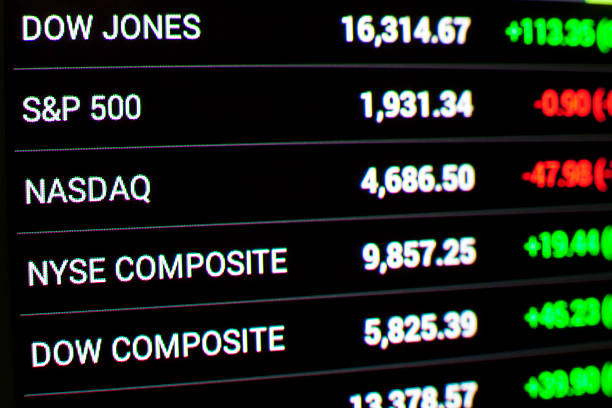The Live Dow Stock Market is a cornerstone of global financial markets, serving as an indicator of the performance and health of some of the most significant publicly traded companies in the United States. In this article, we’ll dive into the essence of the Dow, its role in financial markets, how it operates, and why monitoring the live Dow stock market matters to investors, businesses, and the economy.
What Is the Dow Jones Industrial Average?
Often just called the “Dow,” the Dow Jones Industrial Average (DJIA) is a stock market index that monitors the performance of 30 well-known businesses listed on the U.S. stock exchanges. These businesses span a wide range of sectors, including consumer goods, healthcare, technology, and finance.
The Dow is a price-weighted index, which means that businesses with higher stock prices, independent of their market capitalisation, have a bigger influence on the index’s movement than other stock market indexes.
Key Characteristics of the Dow
- 30 Blue-Chip Companies: The Dow comprises 30 well-established and financially stable companies.
- Price-Weighted Index: Higher stock prices of individual companies carry more weight.
- Diverse Industries: Represents industries such as technology (Apple, Microsoft), finance (Goldman Sachs, JPMorgan Chase), and healthcare (Johnson & Johnson).
- Historic Significance: Established in 1896 by Charles Dow and Edward Jones, it’s one of the oldest indices in the world.
What Does the Live Dow Stock Market Represent?
The live Dow stock market reflects the real-time performance of the index during trading hours, typically from 9:30 a.m. to 4:00 p.m. Eastern Time. Monitoring the live market provides insights into investor sentiment and market trends.
Also Read: New York Stock Market Opening Hours: When to Trade
Why Is It Important?
- Economic Indicator: The Dow is regarded as a gauge of American economic health.
- Market Trends: Real-time changes reveal investor confidence or concern.
- Investment Decisions: Helps investors track performance and make informed trades.
How the Dow Is Calculated
The values of each of the 30 component stocks are added up and then divided by a divisor to determine the Dow. To keep the index consistent, the divisor accounts for stock splits, dividends, and other company actions.
Formula:
Dow Jones Index=Sum of Stock PricesDow Divisor\text{Dow Jones Index} = \frac{\text{Sum of Stock Prices}}{\text{Dow Divisor}}Dow Jones Index=Dow DivisorSum of Stock Prices
The Dow divisor makes sure that shifts in the prices of individual stocks don’t have an outsized impact on the index.
How to Monitor the Live Dow Stock Market
Monitoring the live Dow stock market is essential for investors, traders, and analysts. Here’s how you can track it:
- Financial News Platforms: Websites like CNBC, Bloomberg, and MarketWatch provide real-time updates.
- Stock Market Apps: Apps such as Yahoo Finance, Robinhood, and Webull offer live tracking.
- Brokerage Platforms: Many online brokers provide live Dow data alongside tools for analysis.
- Financial TV Channels: Channels like CNBC and Fox Business broadcast live market updates.
Tools for Analyzing the Live Dow
- Charts: Real-time charts help visualize trends.
- News Feeds: Immediate access to breaking news affecting the market.
- Indicators: Moving averages, RSI, and MACD to assess trends.
Factors That Influence the Live Dow Stock Market
The movement of the live Dow stock market is influenced by several factors:
1. Economic Data Releases
Reports such as GDP growth, employment data, and inflation impact investor sentiment.
2. Corporate Earnings Reports
Quarterly earnings reports of Dow-listed companies can cause fluctuations.
3. Federal Reserve Policies
Interest rate decisions and monetary policies directly affect market movements.
4. Global Events
Volatility can be caused by pandemics, natural disasters, and geopolitical tensions.
5. Sector-Specific Trends
Trends in specific industries, such as technology or energy, can influence the index.
Benefits of Tracking the Live Dow Stock Market
1. Informed Investment Decisions
Live data allows investors to react to market conditions instantly.
2. Risk Management
Real-time updates help in identifying risks and adjusting portfolios accordingly.
3. Economic Insight
Tracking the Dow provides insights into broader economic trends.
4. Trend Analysis
Short-term traders use live data for technical analysis and day trading strategies.
Challenges in Monitoring the Live Dow Stock Market
While the live Dow stock market is an invaluable tool, there are challenges:
1. Volatility
The market can be highly volatile, with sudden swings influenced by news or events.
2. Overemphasis on Short-Term Trends
Focusing on minute-by-minute changes may distract from long-term investment goals.
3. Information Overload
The volume of data can be overwhelming, especially for new investors.
4. Misinterpretation
Incorrectly analyzing live data can lead to poor investment decisions.
Comparing the Dow to Other Indices
The live Dow stock market is just one of several major indices. Here’s how it compares:
1. S&P 500
- Tracks 500 large-cap companies.
- Market capitalization-weighted.
- Broader representation of the economy.
2. Nasdaq Composite
- Focuses on technology and growth stocks.
- Includes over 3,000 companies.
3. Russell 2000
- Tracks 2,000 small-cap companies.
- Represents smaller businesses.
While the Dow is often the most recognized index, others provide complementary perspectives on market performance.
Tips for Investing in the Dow
1. Diversify
To attain diversity, put money into mutual funds or exchange-traded funds (ETFs) that follow the Dow.
2. Monitor Economic Trends
Stay informed about economic indicators and their potential impact on the Dow.
3. Adopt a Long-Term Perspective
Instead than responding to day-to-day changes, concentrate on long-term objectives.
4. Use Technical and Fundamental Analysis
Combine both approaches for informed decision-making.
Conclusion
The live Dow stock market serves as a vital indicator of the economic and financial health of the U.S. reflecting real-time investor sentiment and market trends. By monitoring the live Dow, investors can make informed decisions, assess economic conditions, and identify opportunities for growth. However, while tracking the index is essential, it’s equally important to maintain a long-term perspective and avoid being swayed by short-term volatility. The Dow’s relevance continues to evolve, but its significance as a barometer of market performance remains unchanged.

